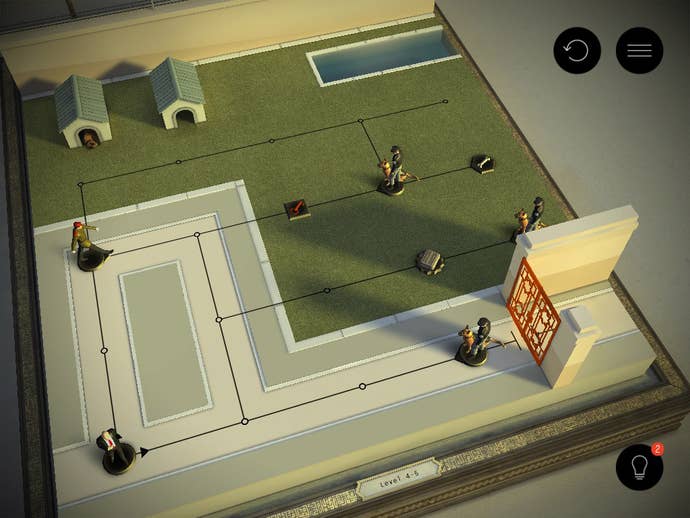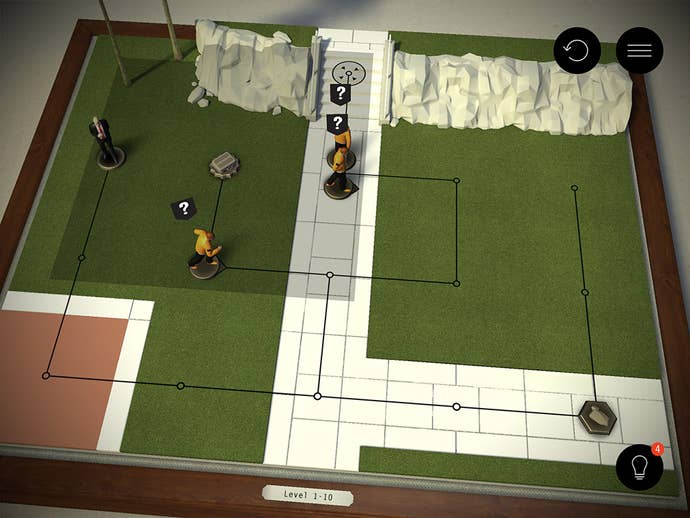Hitman Go iOS Review: Game of Life Meets Game of Death
Yes, classic console and PC franchises really can work on mobile platforms. Agent 47's stylish new outing shows the rest how it's done.
This article first appeared on USgamer, a partner publication of VG247. Some content, such as this article, has been migrated to VG247 for posterity after USgamer's closure - but it has not been edited or further vetted by the VG247 team.
Whenever a major publisher announces a mobile entry in a popular franchise, the Internet's response is swift, noisy, and predictable: Cries of betrayal, tidings of doom, expressions of rage.
Square Enix's Japanese half still hasn't caught on to the blowback that comes hand-in-hand with mobile releases, but at least their Western half (aka Eidos) gets it. The announcement of Hitman Go gave rise to no end of Internet outrage. And yet that fury proved to be misaimed, as Go's developers appear to have designed Agent 47's iOS adventure to systematically dismantle every possible criticism that could be lobbed its way.
Hitman Go makes no effort to recreate the series' intricate 3D stealth assassination action on a touch device. It doesn't try to drop players into an immersive world. It makes no attempt to be realistic or atmospheric. And yet it manages to remain faithful to the spirit of Hitman while simultaneously being magnificently stylish.

Go pares down the mechanics and objectives of Hitman to a virtual board game. It's a reductive approach to stealth that works wonderfully while maintaining its own distinct personality and playing well within the context of a touch device. People used to complain that you could play Metal Gear Solid by focusing on the radar display in the corner, and that doing so reduced the seemingly complex stealth action to a glorified version of Pac-Man. Since then, developers working in the stealth genre have done their best to either expand on those limited mechanics or dress them up all fancy-like to disguise their innate simplicity.
Hitman Go makes no such effort. On the contrary, it cheerfully embraces the fundamentals of stealth by stripping the entire thing down to an electronic single-player board game. Similar to 2012's Crimson Shroud, Hitman Go turns Agent 47 into a little playing piece shuffling around a board filled with other little playing pieces that represent briefcases, enemy agents, potted plants for hiding, trap doors, and more. Unlike Crimson Shroud, which supplemented its cool tabletop conceit with reams and reams of narrative, Hitman Go takes a more franchise-appropriate silent-but-deadly approach. There are hints of story contained in the settings (intriguing details like the strange red cloaks your targets wear in the second series of missions), but really it's about working out the puzzle inherent in each level.
You could almost compare Hitman Go to a roguelike – but strictly in the sense that the action is turn-based, with the player always moving first. This detail mainly exists to provide the basic framework for the rules laid atop the game, though. Hitman Go operates under a very consistent set of rules, requiring a bit of forethought for the increasingly complex stage setups, and each of the nearly 100 individual missions plays out like an action puzzle.

Agent 47 can kill any target he takes from the side or behind, but anyone who spots him first will kill him instead. You can hide in plants. You can sneak past guards provided you're wearing their uniform. You always have to make a move of some sort. When you come across an interactive object, such as a rock to throw and draw the guards' attention, you always have to interact with it.
From these simple restrictions, Hitman Go creates an elaborate, entertaining series of self-contained puzzle stages packed with personality and style. Despite its no-frills, no-fuss style, the missions can be devastatingly tricky. Each mission has multiple objectives, often including an award for economy of movement, and you'll need to earn full marks on quite a few stages in order to unlock later boards; simply clearing every mission on a board with your basic objective complete isn't enough to open subsequent boards. That being said, you can unlock later stages for a modest fee if you prefer, but pay-to-play is simply an option and the more proper way to access that content is simply to earn it with smart, efficient play. Besides, given how thoughtfully the challenges are designed, it seems rather like missing the point to skip past them.
The Breakdown:
- Graphics: Minimal but stylish, like the best European graphic design.
- Audio: Equally spare – mostly ambient sounds – with just enough detail to convey the sensation of playing a board game.
- Interface: Brilliant. Turning stealth action into a board game might seem almost cheekily reductive, but Hitman Go plays it straight and owns its premise. Simple, clean, and effective.
- Lasting Appeal: There are a ton of stages to complete, and the parameters for advancement are pretty steep – it'll take quite a while to play through legitimately, let alone totally master the game.
ConclusionA shining example of a mobile adaptation done right, Hitman Go's creators clearly understand both the essence of the franchise and the limitations of the platform. The resulting synthesis is nothing less than brilliant.








